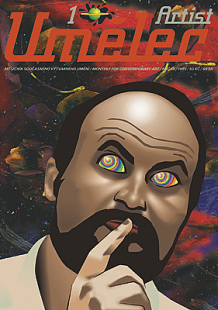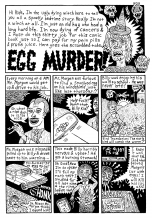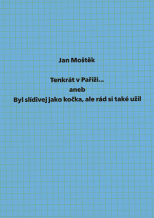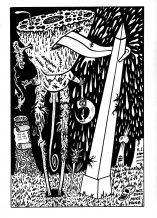| Časopis Umělec 1998/1 >> Malamut | Přehled všech čísel | ||||||||||||
|
|||||||||||||
MalamutČasopis Umělec 1998/101.01.1998 Václav Stratil | reportáž | en cs |
|||||||||||||
|
I decided to take a night train to Ostrava. It came from the Balkans and looked like everybody was ready to take part in the Ostrava performance festival as it was very joyful and loud. I sat myself in a smoking compartment full of perhaps Albanian passangers who talked aloud, as if they were singing an Oriental song. Just once I left to go for a walk.
I got off in Ostrava at 2 a.m. and in the cab I found out that my wallet got stolen from my coat. Fortunately, I had another 100 crowns in my pants. At the Spider’s bar I found Petr Lysáček and Jiří Surůvka who took care of me. Surůvka was laying on a sofa as he wanted to celebrate the Malamut festival in Roman style. The whole festival was to happen during the next 24 hours. I most enjoyed those performances that were addressing general public. It was a shy morning and Marián Palla was selling something dumb on the central square, a nail or a string. A bit further, Vladimír Havlík was walking around with a suspicious look on his face, covered with a long black coat. When he spotted a passer-by, he started flashing his color painting, hanging on his croch. The festival peaked at noon. Jiří Surůvka, dressed in Batman suit, arrived to a department store to buy winter shoes on the account of Malamut. When I was coming to Ostrava, I imagined that I would make a little performance on Jaroslav Anděl and try to fly in Ostrava’s House of Arts. It was all a bit different. Petr Lysáček found exceptionally damaged and rotting clothes, dirty from construction work. We got dressed and went to see a boring exhibition at the House of Arts. The cashier started protesting and called the director whose stone face and silence suggested that he was not at all interested in anything let alone Malamut. I’m not sure whether he is competent to be in his position in this institution which deals with contemporary art since he ignores Malamut. He would probably prefer the festival to be banned all together. Such an institution should actively cooperate with the festival, it should create an umbrella for it. Then there was a night program which was to be expected and everybody set off to the Spider’s. It was 2 a.m. and Jiří Surůvka thought there would be a party. Instead, the personnel announced the last call. Jiří got pissed off and started cursing in a very complex manner. I haven’t heard such a concise and homogenous structure of cursing in a really long time. He was running around the bar and since it was very dimly lit, he was disappearing in the darkness and then mystically reappearing. So we chose to go to another bar where we stayed till 5 a.m. When we had enough drinks, we set off to bed. There were three of us. Surůvka, Havlík and I. I didn’t know that the main performance was still to start. Quite worn out driver, a rickety Škoda. Surůvka started the vehicle and drove very fast, played some punk music really loud and I’m not sure how much he was actually able to see. He rushed through several curves and started up a big hill. In the middle of it, we ran out of gas and had to get out to the freezing weather and smog. Ostrava was blinking feebly beneath. The car went down the hill and we were not strong enough to at least get it off the road. All of a sudden, as some sort of a fanthom, a huge angry truck appeared behind us. It ventilated its anger by crashing our car’s blinker and kicked it off the road. We walked to a gas station. Surůvka then marched off to get the damaged car and I and Havlík loaded ourselves with fried cheese. We drove to Surůvka’s apartment and fell deep asleep. Havlík was probably the worst off as he slept in a net. When we woke up, Surůvka said he had to go and teach a lesson. Pop-art. I offered that I could teach instead of him because I just had a show in Ostrava. I took the students there and got some money for it. On the way back to Prague, I was mostly silent. I got off at the Main Station and talked with some Gypsies for a while who were inspired by my hat. They wanted me to get them some women and were intrussive in a noble way. Then we said good-bye and the next day I found out that they had stolen the money I had made in Malamut. Non-Western Festival By Milena Slavická, pages 8 through 10 The international biennial in Monte Negro which took place from September 20 until November 2 has been organized for the third time since 1991. The former royal palace in Centinj housed works by artist from the “eastern“ as well as the “western“ art worlds. Monte Negro’s Ministry of Culture funded the festival with 400.000 USD. Is it mere madness or a proof of how a government in a country with much greater problems than ours appreciates contemporary art? The festival aims to present “western“ and “eastern“ art in balanced proportions and try to create new art contexts. The fact that renowned international art shows first “couldn’t“ present artists from the “eastern block“ while now they don’t want to do it is not just surprising but suspicious. The festival’s commissioner Andrei Yerofeyev outlined three themes for the biennial. The first one, called Back And Forth, aimed to reflect new living and creative conditions of artists who spend most of their time travelling. Their work is not being created in the intimate world of their studios any more, in protected privacy, in an artistic microclimate. Artists are permanently exposed to “strangeness“ of new environments and hardships of travelling. Thanks to various grants and exhibitions, they travel from place to place, back and forth becoming the art-homeless. Their studios are just their own heads. (I may note that in case of Czech artists, the grants and exhibition travels are not that big of an issue.) The topic was not limited only to new living situation of artists, it also aimed to reflect new situation in general: current migration waves, relocation of groups, villages, ethnical minorities, travelling for work, adventure, tourist shopping attacks especially from former communist countries, as well as tragic travelling of refugees running from hunger or political terror. The main hall was dominated by seven-meter-long and four-meter-tall lithography of an attractive mountain landscape with a small, romantic church in a pass, reminding of luxurious wall-paper in hotel lobbies. Just like Khammurabi’s sign, a message was carved in the rock: “Susan, wait here, I went to get some pizza“. This work was by Belgium artist Wim Delvoy. Also in this hall were large color photographs by an Austrian artist Loise Rener. They showed an interior of a studio where he “travels every morning“. These intertwined fictitious and real spaces, details of certain objects or parts of the interior created a complex and illusory environment - sort of an image of the artist’s inner world. The distant, cold aesthetics of perfect photographs was in contrast to the work’s content. Petr Nikl’s series of photographs, on the other hand, showed provocative romantic form - a dreamy, imaginary space where the viewer may travel through countryside of his/her imagination. Suitcases packed with travel catalogues, maps, photographs, postcards were made by Anne and Patric Poirier of France. Next to them were “photostories“ about travels through Siberia by Sophie Calle, France. B.K.S. used suitcases in much different way and occupied one entire room with them. Eleven suitcases from the B.K.S. archives went through a security check at the airport, they were X-rayed and pictures from the monitors were transformed into color photographs. They created beautiful abstract image compositions which were hung on the walls with the real suitcases underneath. The second topic was entitled The New Icon and was placed into former Parliament building, the Vladin Dom. The exhibited works ranged from social and political icons, religious-blasphemous icons, erotic icons to New Age icons. The political ones looked a bit “dusty“: an instalation with an oltar made of political and military emblems by Boris Orlov, a portrait of Stalin and Marilyn Monroe by Leonid Sokov. An installation by Ernest Letaris, entitled Golgota, ironically portrayed aesthetics of religious-tourist oltars. Comics series by Alexander Savkov of Micky Mouse bearing a cross was very well done. Current “sex icon“ and its various forms appeared in works of many artists: an installation by Noritoshi Hirakawa, Ann and Patric Poirier, Gudrun Kampl. Jiří Surůvka exhibited his double icon of baby Hitler entitled The Twins which appeared strong and original and gave the topic a new context. The third theme, called The Secret Life of King Nikolai, was more or less an addition. The last emperor’s grandson Nikola Petrovich Nyegosh offered the royal palace for “unconspicuous“ interventions. It is unsure in what political situation the next biennial will take place. Nevertheless, it is the only festival which is not set by the “west“. The selection criteria are a bit too liberal but this is also a contribution for the project as one may see many artists who are hard to be seen otherwise. The context which was created here is still raw but all the more interesting.
01.01.1998
Doporučené články
|
|||||||||||||
|
04.02.2020 10:17
Letošní 50. ročník Art Basel přilákal celkem 93 000 návštěvníků a sběratelů z 80 zemí světa. 290 prémiových galerií představilo umělecká díla od počátku 20. století až po současnost. Hlavní sektor přehlídky, tradičně v prvním patře výstavního prostoru, představil 232 předních galerií z celého světa nabízející umění nejvyšší kvality. Veletrh ukázal vzestupný trend prodeje prostřednictvím galerií jak soukromým sbírkám, tak i institucím. Kromě hlavního veletrhu stály za návštěvu i ty přidružené: Volta, Liste a Photo Basel, k tomu doprovodné programy a výstavy v místních institucích, které kvalitou daleko přesahují hranice města tj. Kunsthalle Basel, Kunstmuseum, Tinguely muzeum nebo Fondation Beyeler.
|






























 Stavíme pro tebe Národní galerii! Pojď do Kyjova u Krásné Lípy č.37.
Stavíme pro tebe Národní galerii! Pojď do Kyjova u Krásné Lípy č.37.
Komentáře
Článek zatím nikdo nekomentovalVložit nový komentář